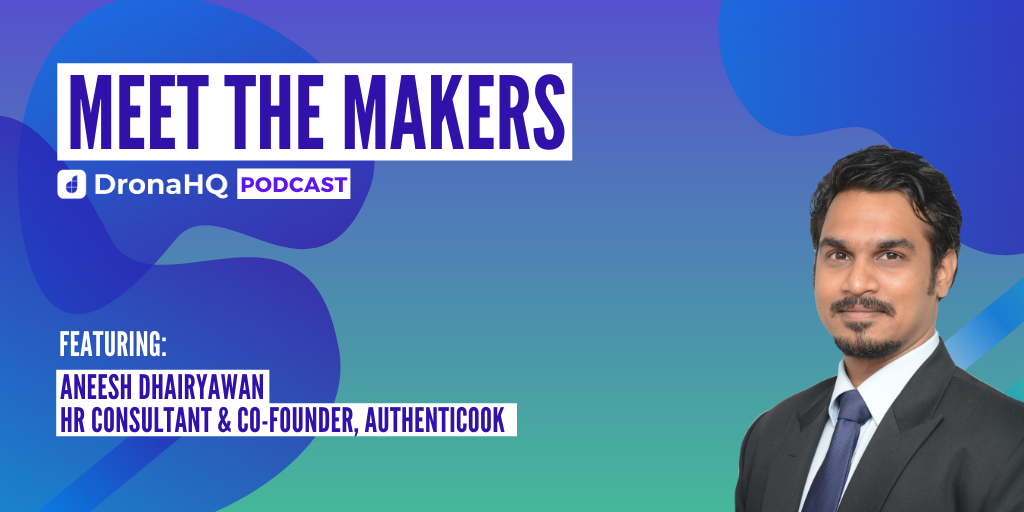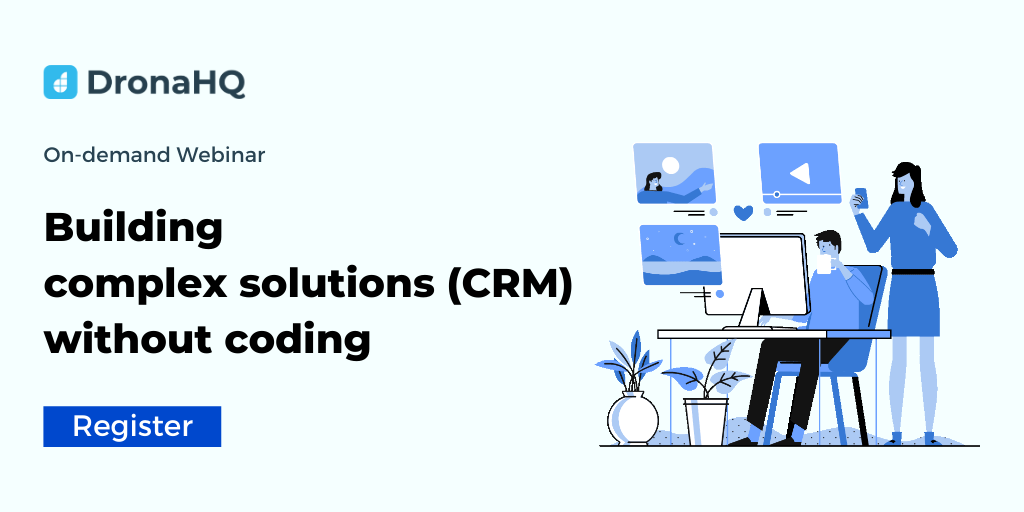

Designing a Production Grade CRM from Scratch
A powerful Customer Relationship Management(CRM) software is an extremely useful tool. It tracks and monitors the communications of your sales representatives with your prospects and clients. It also helps to show prospective leads or clients that may require additional follow-up.
In this episode of the No-Code Insider series, we have Jinen Dedhia, Co-Founder and MD at DronaHQ, walking us through his journey of creating a no-code CRM and what drove him to create the app himself.
You will Understand
- Why did he build the CRM
- What was the logic behind the no-code CRM
- Which tools or third party connectors were integrated with the CRM
- Any Automation implements in your sales/CRM integration
- Was this built completely using No-Code
- How much time did he spend on making this app
- What were the benefits of using no-code
This podcast will help the CIOs, IT heads, entrepreneurs, non-technical founders, and many LoB executives to apply the No-Code technology in their digital initiatives.
(00:00)
Kinjal(K): Hi, this is Kinjal, and today we have Jinen Dedhia, the co-founder of DronaHQ. He heads the Sales and business strategy at DronaHQ. And I’m going to ask him about his very recent liking for CRMs. We had a fantastic CRM webinar done by him. And I’m going to ask a few more questions on the same. Hi, Jinen how are you today?
(00:26)
Jinen[J]: Hey, thank you very much for having me.
Why did he build the CRM?
K(00:29): So I want to understand Jinen, the CRM that you built for DronaHQ recently using the no-code platform. Why did you build the CRM? What you were using before that? Could you just share some insights on that first?
J(00:48): That’s a good question. So obviously, we were using one CRM earlier. We’ve been that CRM for almost three to four years. Obviously, that CRM itself was not being used completely. We had to plug in a lot of support modules from Google Sheets and various other tools to make it work for us. However, we found that we couldn’t really do things the way we wanted to do with that particular CRM. And we constantly felt a need of maybe upgrading or probably building it all by ourselves. So that was one of the primary reasons why we were looking at building our own CRM.
We were using Pipedrive as a CRM earlier and things that were probably not happening in Pipedrive were, we were not able to obtain the market qualification. By market qualification process I mean that every time on the team those add a new lead into the system. Then it had to be assumed. It’s kind of prequalified and that was one thing.
I’m not saying that I just couldn’t do it. Nobody else could have done it on Pipedrive. Second what we really want to do is, we wanted an automatic assortment of sort of leads. We wanted to sort out of everything the hot leads first.
What was the logic behind the no-code CRM?
K(02:47): So, how do we get that logic built?
J(02:49): Pipedrive was pretty rigid. We couldn’t have done anything on top of it, by sorting out my lead spaces and engagement’s goal. So these were some of the difficulties that we were getting into. Our pricing and business model around it will be to sell our no-code platform and what enterprise mobility and other tools that we have as in how it got evolved. We also found that our current CRM was not really in a position where you could link, adjust things to two different business models or come out with the simple pricing calculation and commercial models and so forth.
J(03:41): So that’s when we get another scenario where we couldn’t really go all the way on Pipedrive. And as a result, we came to a point where we just had to plug in a lot of things outside Pipedrive.
K(03:49): And that is the point when you start looking at what we can do to fix this particular problem and start looking towards your own no-code platform.
J(04:10): Yes, actually we did take a look at Salesforce. The idea was very clear. We wanted to have the best in class tools for the sales team, and DronaHQ. Obviously, Salesforce was one of the contenders. We ran into a few troubles with Salesforce as well. It was not so readily out of the box that I could just pick it up and we could do it. So if you sign up on Salesforce.com and if you go through the entire process the tool would suggest for you to get connected to a partner. Now, that is a limiting factor for us. The moment we start defining our processes and give it to a partner and they do it. It doesn’t work in our business that way. We are very agile. We launch every week, one or two major features.
That has an impact on the way we price, the way we market to our customers. And it will also eventually have an impact on our toolings. So we couldn’t really like it. Keep doing this back and forth with a partner to support us. We wanted something where we had complete control over the tool that we are trying to make.
Yeah. So that was one thing. Also, there was another interesting thing while we were between Pipedrive and no code. We also went pro code actually. So we did have a few developers who actually built an entire lead management system for us. That was an interesting thing because we can build it from scratch very specific to our needs.
So we had a pro code experience. We had completely like a SaaS experience with Pipedrive. A little bit of experience of trying to do things at salesforce because it’s much more it gives you much more. But it’s just a bit more difficult to utilize it. So we did all of these things, and then we moved finally to no code.
Which tools or third party connectors were integrated with the CRM?
K(06:32): So tell me something about all other tools or third party connectors that you have used and integrated with your CRM at this moment?
J(06:45): Sure. I will take a step back. So when the journey with our No Code with our CRM began. We did not look at boiling the ocean. We picked up some of the most burning needs while keeping lights on with our existing Pipedrive. Then we went on to keep adding the other important facets of our CRM that we wanted, which was not being serviced by Pipedrive.
That was the first thing that we actually came out with. So if you go through my webinar again, you would see that there was a process of sign-ups. So one of the things that happened in DronaHQ since the last four quarters is, we opened up our entire tooling for anybody to come, sign up and start utilizing it. We had a lot of difficulties while integrating tools around it. For example, we have Intercom and there were a lot of other features.
The DronaHQ platform itself was giving us a lot of information, which again had to be utilized by the sales team to make their conversations a bit smarter. So that they can also have insights in terms of whom they should spend their time with. Now, obviously we did not sunset Pipedrive on the day one.
We picked up our battling in terms of, picking up the sign up from the website and all the way till market qualification. That was the first process that we internally broke down for our entire sales process. In doing that, we integrated with Intercom, our marketing team was also looking for what’s happening in the sales that we can learn in our marketing. We did a two-way integration at that point in time. So that was the first thing that we did. Now, the advantage was immediate because my CRM was already doing the job that it was supposed to do. We built this particular sideline activity, which was not supported by CRM. CRM plus No-Code became the first thing that immediately gave us a nitro booster. That led us to run whatever we were doing a tad bit more efficiently.
And that’s how our journey began. So we kept lights on, on our CRM. We bolted it with no-code and slowly. That’s how, at one point in time, we completely let go of Pipedrive. This CRM was now going to the box.
Any Automation implements in your sales/CRM integration
K(09:55): So you are a very avid promoter of Automations. Any particular automation that you have implemented in part of your sales, and CRM integration.
J(10:16): Absolutely. I think any sales organization if you have to run it in the best manner. I believe automation has to be a part of it. We did a lot of automation in our sales process. Thanks to adopting No-Code because it gave us the entire flexibility that it demanded. So let’s see an example,
The moment any new lead that comes from no matter which different sources. It has to be enriched. So that was the first automation that we went for. Prior to this, we used to ask our reps to spend a lot of time in terms of going and collecting this data. So there are two parts when you’re trying to qualify or gather data and are analyzing the data. Then you are making some decisions based on that data.
Should I spend my time- Yes or No on this? Now thanks to the enrichment that we could do. Of course with some third-party tools. Now, we are in a position to completely automate the lead qualification scoring process. Thanks to that we are kind of saving the reps time by just talking to the pre-qualified leads. Now this gives our reps a huge boost in terms of time. Now they have more time to talk to customers rather than spend time and analyzing whom should they be talking to? Likewise, we did a lot of other smaller things that could qualify as automation. I think there are yet many other things to do. As time progresses, I think we will be adding a lot more capability to this.
Was this built completely using No-Code?
K(12:18): So Jinen, this CRM was completely built using No Code methods and technologies. Did you secretly use some coding skills behind?
J(12:34): So that’s a good question. So, it was completely built on the DronaHQ no-code platform. There is not a single thing that we did outside. That was a clear cut decision for us because we’ve experienced it. If we are going outside and doing things then we are kind of struggling with the pro code. In the pro code world, there is a huge dependency on a developer. With pro code, there’s an ageing effect. Changing that code becomes very difficult.
So it’s a conscious decision to stay away from coding work. The No-Code experience did give us a lot of options. Within the no code, there were some little bit of functions, etc that we had to write on top of it. For example, we wanted to do [for] our reps – a mechanism to see the local time of the customer that they were talking to because we’re a global platform. Each rep has a territory, which is fairly young as a company. So they have a larger territory to cover and that includes multiple time zones.
So it becomes imperative for reps to have real-time visibility of the country in the timeline that they’re talking to and be mindful about that before just going and calling them. So for that little bit, we have to add two additional lines of JavaScript. I wouldn’t call it coding. But if you want to call it. Yes, we did a little bit around there.
How much time did he spend on making this app?
K(14:34): So I would also like to understand how much time you would have spent on this.
J(14:45): Oh, that’s a very good question. So honestly let’s take a step back. Let’s see how business applications are eventually commissioned by any enterprise. Whatever be the size small, mid, large whichever. I mean, now the first thing that happens before a single line of code is ever written. Forget the code ever written. But even being architected even before that happens. You need a very crisp understanding of the business process. You need to document it to the team so that somebody can understand it. Then somebody can work on it to give you commercials, to give you pricing, to give you an estimate of time, cost, etc.
Unless and until you don’t have the document. You are not going to have an estimate of what you are looking for and building. You will not have a complete picture of what you are trying to make. So typically, that’s how business applications are kind of written. The entire process of writing a good process document itself can become a very lengthy process. Thankfully, In our case, I was running the sales process and to be honest. We were a very young and time-pressed organization all the time. Commissioning somebody just to write a document to get us a business document was not really top of my priority. So what we ended up doing is we actually picked up small battles. Think about it, mentally we were agile. So I said the first process that we went for attacking was not really like boiling the ocean and building a complete CRM. We picked up a sign up process. So what we did is, our goal was eventually to wire up an entirely lead to order process. So when I say lead to order signup becomes one of the important elements to that.
Then we expanded on this lead to- It can be from a website, It can come from the G2 crowd, It can come from any other different sources wherever we are running a campaign. So lead to order was our goal. A lot of things were happening on Pipedrive. We just picked up the lead to qualification as my goal no. 1. For doing that it took me four to five hours. And we put that particular thing in place and tested it pretty much.
After that, we continue to run. Next day for the reps a little bit of training. From tomorrow, we’re going to have a little bit of change in our process. I mean instead of finding leads straight in your mailbox. You’re going to find it in an app. We have used DronaHQ as our goto tool for all things business. So there’s a micro app just go, click it and you’ll find leads and then they go start doing the work as usual.
As a next step, we realized. Why not let our sales guys complete the communication process and tell us when they eventually conducted the lead. What was the conversation like? What was their learning that we did not have? It had to be there that could be passed down to the product team. Anything from that conversation that can be passed to the marketing team. So we picked up small little things. We spent a couple of hours and we plugged that in. So in the first four hours. We did something from our sign up process, expanded it a little bit to cover all kinds of leads. And then for the next two hours. We added a communication or a feedback loop and took that feedback and passed it on to different departments.
So as simple as that. That’s how we began. When the time progressed another couple of hours. We kept adding multiple other things. Very recently, last week maybe two weeks back. We added functionality of integrating with voice calling mechanism. Last week, we also made sure that the web dialer is even giving this information in terms of how many times, how many minutes or seconds that they talk to the customer. On the basis of that, we are trying to draw insights about that particular prospect. We went on to do a lot of different things. If you ask me all put together, we would have spent around maybe two to three weeks to come to this point.
What were the benefits of using no-code?
K(20:19): Oh, that’s fantastic. Actually, that’s surprising. You have stitched it piece by piece and got to the place where you want to go and probably you are evolving and you would add more pieces to it.
J(20:32): Absolutely. So as we speak. Our teams are equally excited because now they’re giving this feedback. Can we have this? Can we have that? So now there’s a huge backlog, one like, what the team is demanding in a way. I’m going to put one person on the job to keep building on top of this because now the backlog is pretty high. We already have an internal digital transformation team. So we just go and expand that team and hand over this to that team. So that they can continue to make more tools on top of it.
K(21:07): This is the reason why No Code exists in the place because you don’t have to create a complete document in the first place. You can slowly evolve and can add things and be agile as you want.
J(21:22): I completely agree with that because at the moment you want to define your entire process end to end, somebody will stitch it into a working application if that is. It has a perishable life because your business will keep adding more and more things. Your needs are only going to expand. If you’re not going to have somebody working on it then obviously you are not going to evolve at that same speed.
So I think no code really suits us internally. We are going to do a lot more on top of it to make sure that we are in sync with what our business needs all the time.
K(22:11): I think that’s a fantastic note to take this to the end of our podcast today. We understand you are not just talking No Code. You are implementing it as an example of No Code. Implementing it internally, understanding, and reaping the benefits. As you grow, your business needs will grow, your change management, your agile processes, everything will come together and you can implement No Code in a fantastic way for your business and have your transformations in place.
Great to have you here Jinen today on this podcast. I hope we all gain something on how Jinen implemented his digital needs of CRM and switching a sales process from lead to order using No Code technology. If you have any questions, do feel free to put it up in the comments and give us feedback on this podcast. Have a nice day Jinen.
J(23:14): Thank you very much.
Let us know what you think by commenting below, or drop us an email at inquiries@dronahq.com!
Connect with us:
Twitter https://twitter.com/DronaHQ/
LinkedIn https://www.linkedin.com/DronaHQ/
Facebook https://www.facebook.com/DronaHQ/
Instagram https://www.instagram.com/DronaHQ/



